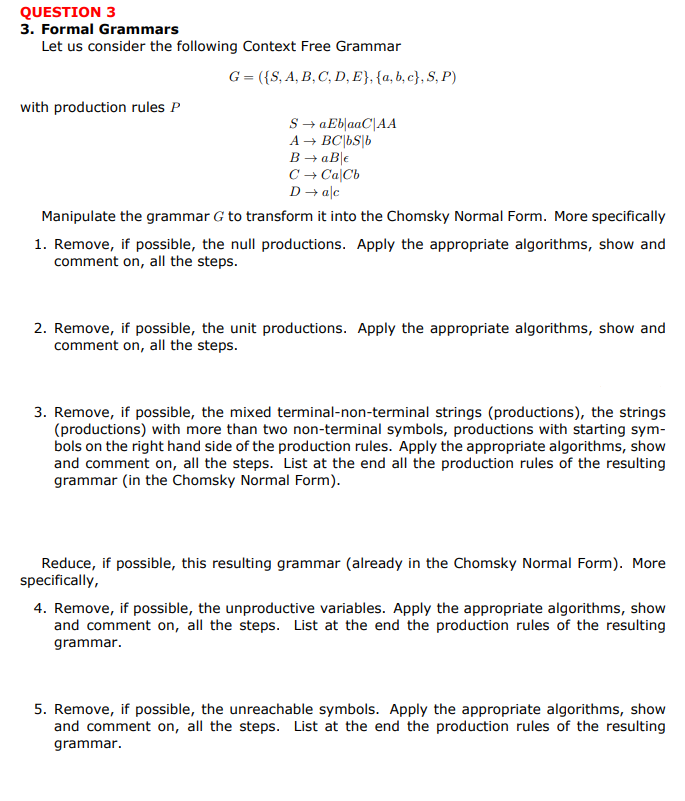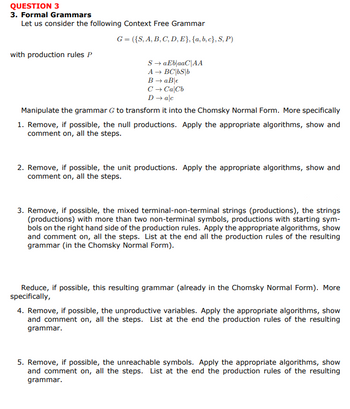3. Forma Let us consider the following Context Free Grammar G = ({S, A, B, C, D, E}, {a,b,c}, S, P) with production rules P SaEblaaC|AA A → BC|bs|b B → aBle C → Ca Cb D → alc Manipulate the grammar G to transform it into the Chomsky Normal Form. More specifically 1. Remove, if possible, the null productions. Apply the appropriate algorithms, show and comment on, all the steps. 2. Remove, if possible, the unit productions. Apply the appropriate algorithms, show and comment on, all the steps. 3. Remove, if possible, the mixed terminal-non-terminal strings (productions), the strings (productions) with more than two non-terminal symbols, productions with starting sym- bols on the right hand side of the production rules. Apply the appropriate algorithms, show and comment on, all the steps. List at the end all the production rules the resulting grammar (in the Chomsky Normal Form).
3. Forma Let us consider the following Context Free Grammar G = ({S, A, B, C, D, E}, {a,b,c}, S, P) with production rules P SaEblaaC|AA A → BC|bs|b B → aBle C → Ca Cb D → alc Manipulate the grammar G to transform it into the Chomsky Normal Form. More specifically 1. Remove, if possible, the null productions. Apply the appropriate algorithms, show and comment on, all the steps. 2. Remove, if possible, the unit productions. Apply the appropriate algorithms, show and comment on, all the steps. 3. Remove, if possible, the mixed terminal-non-terminal strings (productions), the strings (productions) with more than two non-terminal symbols, productions with starting sym- bols on the right hand side of the production rules. Apply the appropriate algorithms, show and comment on, all the steps. List at the end all the production rules the resulting grammar (in the Chomsky Normal Form).
Database System Concepts
7th Edition
ISBN:9780078022159
Author:Abraham Silberschatz Professor, Henry F. Korth, S. Sudarshan
Publisher:Abraham Silberschatz Professor, Henry F. Korth, S. Sudarshan
Chapter1: Introduction
Section: Chapter Questions
Problem 1PE
Related questions
Question

Transcribed Image Text:QUESTION 3
3. Formal Grammars
Let us consider the following Context Free Grammar
G = ({S, A, B, C, D, E}, {a,b,c},S,P)
with production rules P
S → aEb|aaC|AA
A → BC|bs|b
B → aB €
C → CalCb
D → alc
Manipulate the grammar G to transform it into the Chomsky Normal Form. More specifically
1. Remove, if possible, the null productions. Apply the appropriate algorithms, show and
comment on, all the steps.
2. Remove, if possible, the unit productions. Apply the appropriate algorithms, show and
comment on, all the steps.
3. Remove, if possible, the mixed terminal-non-terminal strings (productions), the strings
(productions) with more than two non-terminal symbols, productions with starting sym-
bols on the right hand side of the production rules. Apply the appropriate algorithms, show
and comment on, all the steps. List at the end all the production rules of the resulting
grammar (in the Chomsky Normal Form).
Reduce, if possible, this resulting grammar (already in the Chomsky Normal Form). More
specifically,
4. Remove, if possible, the unproductive variables. Apply the appropriate algorithms, show
and comment on, all the steps. List at the end the production rules of the resulting
grammar.
5. Remove, if possible, the unreachable symbols. Apply the appropriate algorithms, show
and comment on, all the steps. List at the end the production rules of the resulting
grammar.
Expert Solution
This question has been solved!
Explore an expertly crafted, step-by-step solution for a thorough understanding of key concepts.
This is a popular solution!
Trending now
This is a popular solution!
Step by step
Solved in 2 steps with 3 images

Follow-up Questions
Read through expert solutions to related follow-up questions below.
Follow-up Question

Transcribed Image Text:QUESTION 3
3. Formal Grammars
Let us consider the following Context Free Grammar
G = ({S, A, B, C, D, E}, {a,b,c},S,P)
with production rules P
S → aEb|aaC|AA
A → BC|bs|b
B → aB €
C → CalCb
D → alc
Manipulate the grammar G to transform it into the Chomsky Normal Form. More specifically
1. Remove, if possible, the null productions. Apply the appropriate algorithms, show and
comment on, all the steps.
2. Remove, if possible, the unit productions. Apply the appropriate algorithms, show and
comment on, all the steps.
3. Remove, if possible, the mixed terminal-non-terminal strings (productions), the strings
(productions) with more than two non-terminal symbols, productions with starting sym-
bols on the right hand side of the production rules. Apply the appropriate algorithms, show
and comment on, all the steps. List at the end all the production rules of the resulting
grammar (in the Chomsky Normal Form).
Reduce, if possible, this resulting grammar (already in the Chomsky Normal Form). More
specifically,
4. Remove, if possible, the unproductive variables. Apply the appropriate algorithms, show
and comment on, all the steps. List at the end the production rules of the resulting
grammar.
5. Remove, if possible, the unreachable symbols. Apply the appropriate algorithms, show
and comment on, all the steps. List at the end the production rules of the resulting
grammar.
Solution
Knowledge Booster
Learn more about
Need a deep-dive on the concept behind this application? Look no further. Learn more about this topic, computer-science and related others by exploring similar questions and additional content below.Recommended textbooks for you

Database System Concepts
Computer Science
ISBN:
9780078022159
Author:
Abraham Silberschatz Professor, Henry F. Korth, S. Sudarshan
Publisher:
McGraw-Hill Education

Starting Out with Python (4th Edition)
Computer Science
ISBN:
9780134444321
Author:
Tony Gaddis
Publisher:
PEARSON

Digital Fundamentals (11th Edition)
Computer Science
ISBN:
9780132737968
Author:
Thomas L. Floyd
Publisher:
PEARSON

Database System Concepts
Computer Science
ISBN:
9780078022159
Author:
Abraham Silberschatz Professor, Henry F. Korth, S. Sudarshan
Publisher:
McGraw-Hill Education

Starting Out with Python (4th Edition)
Computer Science
ISBN:
9780134444321
Author:
Tony Gaddis
Publisher:
PEARSON

Digital Fundamentals (11th Edition)
Computer Science
ISBN:
9780132737968
Author:
Thomas L. Floyd
Publisher:
PEARSON

C How to Program (8th Edition)
Computer Science
ISBN:
9780133976892
Author:
Paul J. Deitel, Harvey Deitel
Publisher:
PEARSON

Database Systems: Design, Implementation, & Manag…
Computer Science
ISBN:
9781337627900
Author:
Carlos Coronel, Steven Morris
Publisher:
Cengage Learning

Programmable Logic Controllers
Computer Science
ISBN:
9780073373843
Author:
Frank D. Petruzella
Publisher:
McGraw-Hill Education